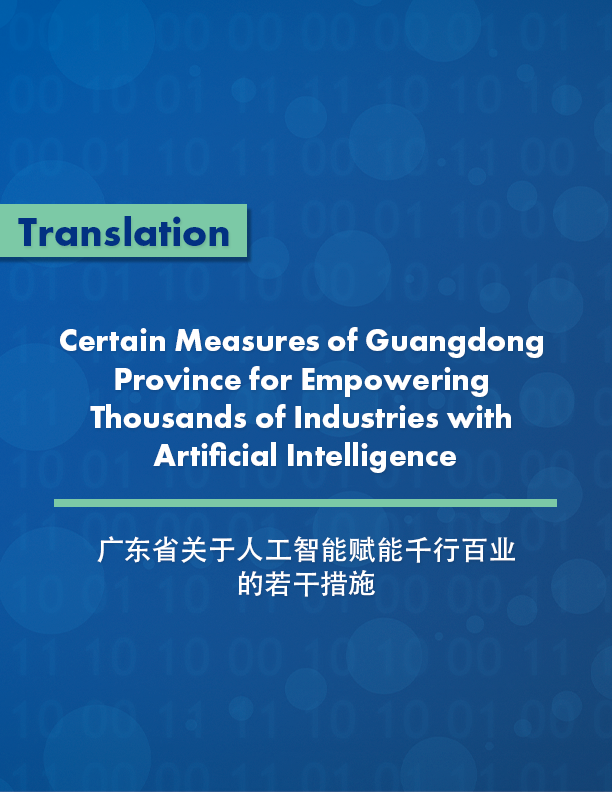The following document outlines the near-term AI industrial policy of Guangdong Province, a technologically advanced region in southern China. The policy’s main objective is to increase Guangdong’s total compute by 50% between 2025 and 2027 to support the AI industry. The policy also emphasizes strengthening AI-related industries and resources such as specialized AI chips, smart sensors, industrial design software, Chinese-language datasets, and domestically developed algorithms.
An archived version of the Chinese source text is available at: https://perma.cc/MA22-ZA8J
Certain Measures of Guangdong Province for Empowering Thousands of Industries with Artificial Intelligence
These measures were formulated in order to implement the decisions and deployments of the Party Central Committee and the State Council on promoting the development of artificial intelligence (AI), to spur high-quality development of the AI industry in our province, to accelerate the formation of new productive forces (新质生产力), to establish a modern industrial system, to empower thousands of industries to improve quality and efficiency, and to create a new economic model, a new experience of life, and new approaches to governance in the intelligence age.
I. Overall Objectives
By 2025, the province’s computing power (“compute”) is to exceed 40 EFLOPS and the core AI industry to surpass 300 billion Chinese yuan Renminbi (RMB). By 2027, the foundation of the province’s AI industry is to be further consolidated, with compute in excess of 60 EFLOPS and a nation-leading algorithm system and compute network system essentially having taken shape. Smart terminal products will be plentiful, with more than 100 widely used smart terminal products developed in eight major categories including mobile phones, computers, home appliances, and robots. The core AI industry is expected to surpass RMB 440 billion. Additionally, more than 500 application scenarios are to be developed with a focus on sectors such as manufacturing, education, and elder care, leading to a significant increase in labor productivity across various industries.
II. Consolidate AI’s Base, and Accelerate the Formation of New Productive Forces
(i) Increase the supply of AI core chips and components.
- We must build an AI chip ecosystem. We must establish a development ecosystem for adaptive chips (适配芯片), target areas such as home appliances, security monitoring, and medical devices, and increase the development and production of high-performance, low-power terminal-side chips. We must encourage enterprises to advance the research and development (R&D) of modules for communication, display, and audio through the integration of processors, radio frequency (RF) communication, intelligent sensors, and memory. We must cultivate a chip innovation and development ecosystem and explore chip R&D and applications in areas such as in-memory computing, brain-inspired computing, chiplets, and instruction sets. We must promote cloud-side and terminal-side chip applications and expand the deployment of high-performance cloud-side intelligent servers. By 2027, we must take the first steps towards establishing an AI chip ecosystem.
- Build an intelligent perception industrial system. We must develop industrial clusters and characteristic (特色) industrial parks for intelligent sensors, promote the development and industrialization of image, sound, and touch sensors, and accelerate the development and mass production of biometric feature recognition and image perception sensors in the fields of consumer electronics and home appliances. We must promote ecological synergies among industries such as processing and manufacturing, integrated packaging, and metrology and testing. We must double the size of the high-end intelligent sensor industry by 2027.
To view the rest of this translation, download the pdf below.
